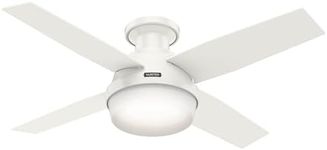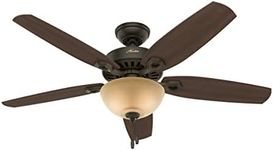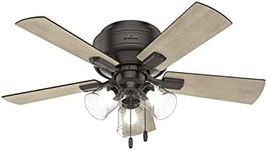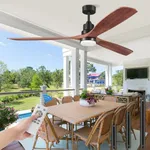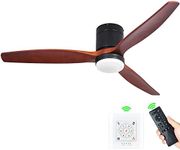Buying Guide for the Best Bright Light Ceiling Fan
Choosing the right bright-light ceiling fan involves considering several key specifications to ensure it meets your needs for both air circulation and lighting. A ceiling fan with integrated lighting can serve dual purposes, making it a practical addition to any room. To make an informed decision, you should understand the importance of each specification and how it aligns with your requirements.Blade SizeBlade size refers to the diameter of the fan when measured from the tip of one blade to the tip of the opposite blade. This spec is important because it determines the fan's ability to circulate air effectively in a room. Blade sizes typically range from 29 inches to 60 inches or more. For small rooms (up to 75 square feet), a blade size of 29-36 inches is suitable. Medium-sized rooms (76-144 square feet) benefit from 36-42 inches, while large rooms (145-225 square feet) require 44-50 inches. For very large spaces (over 225 square feet), consider fans with blades 50 inches or larger. Choose a blade size that matches the room size to ensure efficient air circulation.
Motor PowerMotor power, measured in watts, indicates the strength of the fan's motor. This spec is crucial because a more powerful motor can move more air and is generally more durable. Motor power can range from around 30 watts for smaller fans to over 100 watts for larger, more powerful models. For a small room, a motor with lower wattage is sufficient, while larger rooms or spaces with higher ceilings may require a more powerful motor to ensure adequate air movement. Consider your room size and ceiling height when selecting motor power.
Light OutputLight output, measured in lumens, indicates the brightness of the integrated light. This is important because it determines how well the fan can illuminate a room. Light output can range from 800 lumens (equivalent to a 60-watt incandescent bulb) to over 3000 lumens for very bright models. For general room lighting, aim for at least 1600 lumens. If the fan is the primary light source, you may need higher lumens, especially in larger rooms. Consider the room's lighting needs and whether the fan will be the main or supplementary light source.
Control OptionsControl options refer to how you operate the fan and its light. This can include pull chains, wall switches, remote controls, or smart home integration. This spec is important for convenience and ease of use. Pull chains are basic and reliable but may be less convenient. Wall switches offer easy access but require installation. Remote controls provide flexibility and convenience, especially in larger rooms. Smart home integration allows you to control the fan and light via smartphone apps or voice commands. Choose control options based on your preference for convenience and your existing home setup.
Energy EfficiencyEnergy efficiency indicates how much electricity the fan uses relative to the amount of air it moves and light it produces. This is important for reducing energy costs and environmental impact. Look for fans with an Energy Star rating, which signifies they meet strict energy efficiency guidelines. More efficient fans use less electricity, which can save you money over time. Consider energy efficiency if you are concerned about energy consumption and want to minimize your utility bills.
Noise LevelNoise level refers to the amount of sound the fan produces while operating. This is important for maintaining a comfortable and quiet environment. Noise levels can vary significantly between models, with some fans designed to operate almost silently. If you plan to use the fan in a bedroom or a quiet space, look for models specifically marketed as 'quiet' or 'silent.' For living areas where noise is less of a concern, standard models may suffice. Consider the intended room and your sensitivity to noise when selecting a fan.

